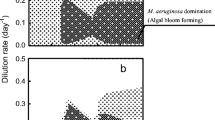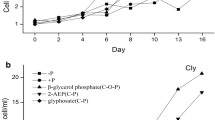Abstract
In Lake Tega, Japan, the shift of dominant algal species was caused as a result of discharging water from the adjacent river into the lake. The transition from cyanobacteria (mainly the genus Microcystis) to diatoms (mainly the genus Cyclotella) resulted in a disappearance of algal blooms. Although some environmental conditions such as flow rate, nutrient concentration, and transparency were changed by the project, the decisive factor for the transition has not been clarified yet. For the effective control of algal blooms by water discharge, this study aimed to elucidate the effects of daily renewal rate and nitrogen concentration on the interspecific competition between Microcystis aeruginosa and Cyclotella sp. Monoculture experiments were conducted to obtain growth characteristics for each species and mixed culture experiments were performed to examine their competitive abilities under various daily renewal rates of the culture medium (15 and 30 %) and nitrate concentrations (71.4, 178, and 357 μM). In addition to prepared medium, Lake Tega water was also used for mixed culture experiments. The results showed that the increase in a daily renewal rate contributed to the dominance of Cyclotella sp., while a nitrate concentration had little influence on the competition. We conclude that algal blooms composed of the genus Microcystis would be controlled by maintaining a daily renewal rate up to 30 % or more, which corresponded to the dilution rate of 0.36 day−1, under a nitrate concentration of ≤357 μM. The study would include essential information for the management of lakes suffering from frequent occurrences of algal blooms.






Similar content being viewed by others
References
Amano Y, Sakai Y, Sekiya T, Takeya K, Taki K, Machida M (2010) Effect of phosphorus fluctuation caused by river water dilution in eutrophic lake on competition between blue-green alga Microcystis aeruginosa and diatom Cyclotella sp. J Environ Sci 22:1666–1673
Brookes JD, Ganf GG (2001) Variations in the buoyancy response of Microcystis aeruginosa to nitrogen, phosphorus and light. J Plankton Res 23:1399–1411
Chiba Prefectural Government (2015) Water quality for lakes in Chiba Prefecture. http://www.pref.chiba.lg.jp/english/index.html. Accessed 14 Sept 2015
Fábregas J, Cid A, Morales E, Cordero B, Otero A (1996) Discrepancies between cell volume and organic content in semi-continuous cultures of a marine microalga. Lett Appl Microbiol 22:206–208
Guillard RRL, Lorenzen CJ (1972) Yellow-green algae with chlorophyllide c. J Phycol 8:10–14
Herbert D, Elsworth R, Telling RC (1956) The continuous culture of bacteria; a theoretical and experimental study. J Gen Microbiol 14:601–622
Hoskisson PA, Hobbs G (2005) Continuous culture—making a comeback? Microbiology 151:3153–3159
Hosper H, Meyer ML (1986) Control of phosphorus loading and flushing as restoration methods for Lake Veluwe, The Netherlands. Hydrobiol Bull 20:183–194
Hu L, Hu W, Zhai S, Wu H (2010) Effects on water quality following water transfer in Lake Taihu, China. Ecol Eng 36:471–481
Jagtman E, Van der Molen DT, Vermij S (1992) The influence of flushing on nutrient dynamics, composition and densities of algae and transparency in Veluwemeer, The Netherlands. Hydrobiologia 233:187–196
Jochimsen EM, Carmichael WW, An J, Cardo DM, Cookson ST, Holmes CEM, De Antunes MBC, De Melo Filho DA, Lyra TM, Barreto VST, Azevedo SMFO, Jarvis WR (1998) Liver failure and death after exposure to microcystins at a hemodialysis center in Brazil. New Engl J Med 338:873–878
Jöhnk KD, Huisman J, Sharples J, Sommeijer B, Visser PM, Stroom JM (2008) Summer heatwaves promote blooms of harmful cyanobacteria. Global Change Biol 14:495–512
Kishida N, Akiba M (2009) Nuisance microorganisms in water supply systems: cyanobacteria. Jpn J Food Microbiol 26:195–201 (in Japanese)
Kuwata A, Miyazaki T (2000) Effects of ammonium supply rates on competition between Microcystis novacekii (Cyanobacteria) and Scenedesmus quadricauda (Chlorophyta): simulation study. Ecol Model 135:81–87
Li M, Zhu W, Gao L, Lu L (2013) Changes in extracellular polysaccharide content and morphology of Microcystis aeruginosa at different specific growth rates. J Appl Phycol 25:1023–1030
Ma M, Liu R, Liu H, Qu J, Jefferson W (2012) Effects and mechanisms of pre-chlorination on Microcystis aeruginosa removal by alum coagulation: significance of the released intracellular organic matter. Sep Purif Technol 86:19–25
Monod J (1949) The growth of bacterial cultures. Annu Rev Microbiol 3:371–394
Nakamura K, Homma T, Miyabara Y, Hanazato T, Park H (2013) Effect of the hydraulic turnover rate on the apparent specific growth rate and biomass of Microcystis in Lake Suwa. Nippon Suisan Gakk 79:851–862 (in Japanese)
Nicklisch A (1999) Competition between the cyanobacterium Limnothrix redekei and some spring species of diatoms under P-limitation. Int Rev Hydrobiol 84:233–241
Oglesby RT (1969) Effects of controlled nutrient dilution on the eutrophication of a lake. In: National Academy of Sciences (ed) Eutrophication: causes, consequences, correctives; proceedings of a symposium. National Academy of Sciences, Washington DC, pp 483–493
Paerl HW, Hall NS, Calandrino ES (2011) Controlling harmful cyanobacterial blooms in a world experiencing anthropogenic and climatic-induced change. Sci Total Environ 409:1739–1745
Rajasekhar P, Fan L, Nguyen T, Roddick FA (2012) A review of the use of sonication to control cyanobacterial blooms. Water Res 46:4319–4329
Robarts RD, Zohary T (1987) Temperature effects on photosynthetic capacity, respiration, and growth rates of bloom-forming cyanobacteria. N Z J Mar Freshw Res 21:391–399
Rocha C, Galvão H, Barbosa A (2002) Role of transient silicon limitation in the development of cyanobacteria blooms in the Guadiana estuary, south-western Iberia. Mar Ecol Prog Ser 228:35–45
Romo S, Soria J, Fernández F, Ouahid Y, Barón-Solá A (2013) Water residence time and the dynamics of toxic cyanobacteria. Freshw Biol 58:513–522
Smith VH (1983) Low nitrogen to phosphorous ratios favor dominance by blue green algae in lake phytoplankton. Sci 221:669–671
Sommer U (1986) Phytoplankton competition along a gradient of dilution rates. Oecologia 68:503–506
Takahashi K, Amano Y, Machida M (2012) Growth and competitive characteristics of the blue-green alga Microcystis aeruginosa and the diatom Cyclotella sp. under nitrogen limitation. Jpn J Phycol 60:1–8 (in Japanese)
Takeya K, Kuwata A, Yoshida M, Miyazaki T (2004) Effect of dilution rate on competitive interactions between the cyanobacterium Microcystis novacekii and the green alga Scenedesmus quadricauda in mixed chemostat cultures. J Plankton Res 26:29–35
Tilman D, Kilham SS (1976) Phosphate and silicate growth and uptake kinetics of the diatoms Asterionella formosa and Cyclotella meneghiniana in batch and semicontinuous culture. J Phycol 12:375–383
Welch EB, Barbiero RP, Bouchard D, Jones CA (1992) Lake trophic state change and constant algal composition following dilution and diversion. Ecol Eng 1:173–197
Yoshinaga I (2008) Studies on hydraulic and biochemical phenomena of an irrigation reservoir and ponded water in a paddy field. Bull Natl Inst Rural Eng 47:1–51 (in Japanese)
Zhai S, Hu W, Zhu Z (2010) Ecological impacts of water transfers on Lake Taihu from the Yangtze River, China. Ecol Eng 36:406–420
Acknowledgments
This work was supported in part by the River Fund (no. 27-1211-006) in charge of The River Foundation, Japan, and by the Japan Society for the Promotion of Science (JSPS) KAKENHI Grant Number 15K18142. We would like to express our sincere appreciation to Prof. Dr. Dennis B. George and Prof. Dr. Sharon Berk of Tennessee Technological University for their constructive comments on improving the manuscript. We also thank anonymous reviewers for providing their fruitful suggestions which improved the quality of the manuscript.
Author information
Authors and Affiliations
Corresponding author
Rights and permissions
About this article
Cite this article
Sugimoto, K., Negishi, Y., Amano, Y. et al. Roles of dilution rate and nitrogen concentration in competition between the cyanobacterium Microcystis aeruginosa and the diatom Cyclotella sp. in eutrophic lakes. J Appl Phycol 28, 2255–2263 (2016). https://doi.org/10.1007/s10811-015-0754-7
Received:
Revised:
Accepted:
Published:
Issue Date:
DOI: https://doi.org/10.1007/s10811-015-0754-7




